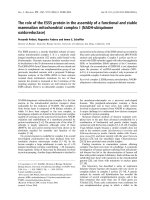Hevea in New Area of Thailand: Success and Growth potx
Bạn đang xem bản rút gọn của tài liệu. Xem và tải ngay bản đầy đủ của tài liệu tại đây (3.8 MB, 25 trang )
Hevea in New Area
of Thailand:
Success and Growth
Warunee Boonnam Pisamai
Chantuma
Darunee Kosaisaiwee Picheat
Prommoon
Since year 1989; Thai government
policy has expanded rubber plantation
to non-traditional area
Background of Rubber Plantation
in Non-traditional area
in 2004; expanded rubber plantations
160,00 ha both in the North and Northeast
High price push farmers to plant rubber
Background of Rubber Plantation
Rubber planting area
Blackground in 2010
South 1.81 mil.ha
East 0.33 mil.ha
NE 0.45 mil.ha
N 0.09 mil.ha
Total area2.70 mil.ha
South
1.81 mil.ha
Recent rubber planting areas (in
2004)
more constraint both land
and environment than rubber
plantations in the past such
as
low soil fertility
unsuitable soil physic
rainfall average only
1,000-1,200 mm./year
To analyze and evaluate
rubber plantations success
in term of statistic
Objective
to khow real problems
to used these data
for further rubber
research and development
-Surveys rubber plantations
in the Northeast region
: 19 provinces
: 1,500 holdings
Material and Methods
Methodology
appointment with farmers
interview to know basic data of each
farm; location, management, workers etc.
collected data in plantation and check
some factors; cultivation, soil and water
source etc.
Data
1 no. survival trees
2. rubber growth
3. soil, environment
4. cultivation and maintenance
5. socio-economic factors: workers
6. girth in each area
- Girth at 1.70 m from
ground
- 100 trees/plantation
Rubber survive, variation and
growth
Results after
5 ½ years
Planting date : 2004 (age 5 1/2 years)
Province Girth std
no
sample tapped
Nakhonrachasrima
35.9 3.1 43 7.0
Chaiyaphum
28.5 7.3 20
-
Udonthanee
34.3 6.7 21 4.8
Nongbualumphu
26.4 5.8 29
-
Ubonratchathanee
31.6 5.4 45 8.9
Umnajchachoeng
29.7 6.7 39 15.4
Sakonnakhon
33.8 4.8 51
-
Planting date : 2004 (age 5 1/2 years)
standard girth : 38.0 cm.,at RRit experimental plots
(Maemeun et al., 1994)
Province Girth std no sample tapped
Khonkaen 28.0 5.3 21 4.8
Mahasalakham 33.1 5.8 8
-
Yasothon 32.0 5.2 40 7.5
Roiet 28.5 5.9 56 10.7
Nakhonphanom 32.9 5.4 48 18.8
Mudahan 33.9 5.2 40 7.5
Surin 31.3 5.4 40
-
Srisaket 31.6 5.6 44 15.9
Loie 28.9 5.7 33 3.0
Nongkhai 33.0 4.8 45 26.7
Kalasin 32.1 6.1 43
-
Burirum 36.5 5.1 41 14.6
Average girth in each provinces 26-35 cm
less than standard girth (38 cm)
Northeast region
Rubber plantations age 5 ½ years have
been tapped 3-27% which girth average
33 cm
Northeast region
17
57
26
0
10
20
30
40
50
60
70
<28 28-38 >38
Girth (cm)
%
Rubber plantation distribution varies girth
Tapped at
7 years
Tapped at
7 ½ years
Tapped at
8 years
standard girth : 38.0 cm, (Maemeun et al., 1994)
average girth : 33.0 cm
Topography, soil and environment
Topography:
75% plantations are flat land
Soil texture:
73% plantations are sandy loam
soil
Water source:
95% plantations are rainfed
area
Average rain 1,000-1,200 mm
Soil chemistry
area pH
OM
%
N
%
Avai P
ppm
Avai K
ppm
Kalasin
4.7-
5.4
0.3-0.9 0.02-0.04 1-19 7-38
optimum
4.5-
5.5
1.0-2.5 0.11-0.25 11-30 >40
Nitrogen : Low
Available P: Low to medium
Available K: Low
Management index
Technology adoption:
- 34% good level
- 55% medium level
Weed control:
48% medium level
Conclusions
Rubber growth in non-
traditional areas are 33 cm
Conclusions
We can predict
- 17% of plantations can be tapped in
May 2010 when age 7 years
- 57% and 26% plantations can be
tapped when age 7 ½ and 8 years
respectively
Conclusions
Both suitable rubber plantation area and
environment are important factors to
encourage rubber plantations success
Conclusions
Moreover the knowledge, maintenance and
interest, habit and behavior of farmers are
more powerful to support rubber plantation
success too









